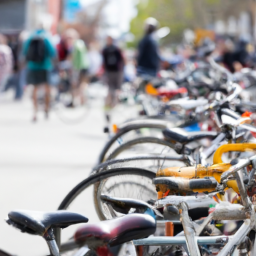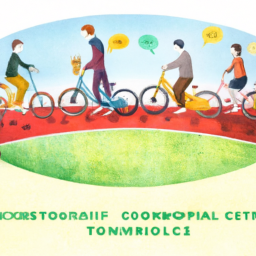Did you know that biking and carpooling can have numerous benefits for both your health and the environment? In fact, studies show that switching to eco-friendly transportation options like these can significantly reduce air pollution, decrease traffic congestion, and even save you money. If you’re looking to make a positive impact while getting around, this article will explore the many advantages of eco-friendly transportation. From different types of bicycles for commuting to tips for safe cycling, we’ll guide you through the practical steps of embracing sustainable transportation choices.
Key Takeaways
- Biking and carpooling reduce air pollution and traffic congestion.
- Eco-friendly transportation options like biking and carpooling save money.
- Carpooling reduces the number of vehicles on the road during peak travel times, reducing traffic congestion.
- Biking and carpooling promote a healthier lifestyle and foster community engagement.
Health Benefits of Eco-Friendly Transportation

Carpooling and biking can significantly improve your health. By choosing these eco-friendly modes of transportation, not only will you contribute to reducing air pollution and traffic congestion, but you will also experience a range of health benefits. Research has shown that regular physical activity, such as cycling or walking from the parking lot to your workplace, can help reduce the risk of chronic diseases like obesity, heart disease, and diabetes.
To encourage more people to embrace carpooling and biking as part of their daily commute, various promotion strategies can be implemented. These may include providing incentives such as discounted or free parking spaces for carpoolers or offering subsidies for purchasing bicycles and related equipment. Additionally, promoting the health benefits associated with these modes of transportation through educational campaigns can help raise awareness among individuals.
The impact of carpooling and biking on urban planning cannot be overlooked either. As more people choose these sustainable options, cities need to adapt by developing infrastructure that supports safe cycling routes and designated carpool lanes. This integration into urban planning helps create a more environmentally friendly city while simultaneously improving public health.
Overall, incorporating carpooling and biking into our daily routines not only contributes to a greener environment but also enhances our overall well-being by promoting physical activity and reducing the risk of chronic diseases.
Environmental Impact of Biking and Carpooling

By biking or sharing rides with others, you can significantly reduce your carbon footprint and contribute to a healthier environment. Biking is an eco-friendly mode of transportation that produces zero emissions and helps combat air pollution. When you choose to bike instead of driving a car, you are not only reducing greenhouse gas emissions but also saving energy. According to research, if everyone in the United States replaced just one car trip with a bike ride each week, it would save 2 billion gallons of gasoline annually.
Carpooling is another effective way to reduce your carbon footprint. By sharing rides with others who have similar destinations, you can decrease the number of vehicles on the road and minimize traffic congestion. Carpooling also helps in conserving fuel and reducing air pollution. In fact, studies have shown that carpooling can reduce CO2 emissions by up to 20%.
In addition to the environmental benefits, biking and carpooling also offer several health advantages. Regular cycling improves cardiovascular fitness, strengthens muscles, and reduces the risk of chronic diseases like heart disease and diabetes. Carpooling allows for social interaction during commutes which can help reduce stress levels.
Cost Savings With Eco-Friendly Transportation

Did you know that incorporating sustainable transportation options into your daily routine can save you money? Choosing eco-friendly modes of transportation like biking or carpooling not only benefit the environment but also provide significant cost savings and economic advantages.
One of the most obvious ways to save money with sustainable transportation is by reducing fuel costs. Biking, for example, requires no fuel at all, which means zero expenses on gasoline or electricity. Carpooling allows you to split the cost of fuel with others in your carpool group, significantly reducing your individual expenditure.
In addition to saving on fuel costs, choosing eco-friendly transportation options can also help you cut down on maintenance and parking fees. Bikes require minimal maintenance compared to cars and are much cheaper to repair. When it comes to parking fees, many cities offer free or discounted parking for bicycles or have designated bike racks where parking is completely free.
Furthermore, adopting sustainable transportation options can even lead to long-term financial benefits. Research has shown that individuals who regularly bike or carpool tend to have lower healthcare costs due to increased physical activity and reduced stress levels.
Reducing Traffic Congestion Through Carpooling

You can significantly reduce traffic congestion by sharing rides with others, which helps to alleviate the strain on our roads and highways. Carpooling is a practical solution for reducing traffic congestion in urban areas. By combining multiple passengers into one vehicle, carpooling reduces the number of vehicles on the road during peak travel times. Research has shown that carpooling can have a significant impact on reducing traffic congestion.
One study conducted in Los Angeles found that if just 1% of single-occupancy vehicles were replaced with carpools, it could result in a 14% reduction in traffic congestion. Another study in Seattle estimated that if every solo driver shared their commute with just one other person, it would reduce rush-hour trips by nearly 50%.
Carpooling not only reduces traffic congestion but also offers several other benefits. It helps to lower carbon emissions and decrease air pollution, as fewer cars are on the road emitting harmful gases. Additionally, carpooling allows individuals to save money by splitting fuel costs and parking fees.
To encourage more people to carpool, cities can implement policies such as designated carpool lanes and preferential parking for carpools. Technology platforms like ride-sharing apps also make it easier for commuters to find compatible carpool partners.
Exploring Different Types of Bicycles for Commuting

Different types of bicycles, such as hybrid bikes and electric bikes, offer convenient and efficient options for commuting. If you are considering using a bicycle for your daily commute, it is important to know about the various accessories that can enhance your riding experience and ensure your safety on the road. Some popular accessories include bike lights, helmets, locks, panniers or bike bags for carrying personal belongings, and fenders to protect you from splashes on wet roads.
When it comes to finding the best bike routes for commuting, there are a few factors to consider. Look for routes that have dedicated bike lanes or paths to ensure your safety and minimize interactions with motor vehicles. You may also want to consider routes that offer scenic views or allow you to avoid heavy traffic areas.
In addition to choosing the right bike accessories and routes, it is important to follow basic safety guidelines while cycling. Always wear a helmet, obey traffic laws, signal your intentions when turning or stopping, and be aware of your surroundings.
Social Benefits of Eco-Friendly Transportation

Using eco-friendly modes of transportation, such as biking or carpooling, can have positive social impacts on our communities. Not only do these methods reduce carbon emissions and promote a healthier lifestyle, but they also bring about economic benefits and foster community engagement.
When individuals choose to bike or carpool instead of driving alone, they contribute to a significant reduction in greenhouse gas emissions. This decrease in pollution helps combat climate change and improve air quality, leading to better overall health for everyone in the community. Moreover, by reducing the number of cars on the road, traffic congestion is alleviated, making commuting faster and more efficient.
Eco-friendly transportation options also have an economic impact on communities. Biking infrastructure creates job opportunities during construction and maintenance phases. Additionally, when people choose to bike or carpool instead of driving their own vehicles, they save money on fuel costs and vehicle maintenance expenses. These savings can be utilized elsewhere in the local economy, benefiting businesses within the community.
Furthermore, embracing eco-friendly transportation encourages community engagement. Biking or carpooling allows individuals to interact with one another during their commute, fostering social connections and promoting a sense of belonging within the neighborhood. It also opens up opportunities for organized group rides or carpools, which further strengthen social bonds among residents.
Tips for Safe and Efficient Cycling

When cycling, it’s important to wear a helmet for safety. But there are other tips you should know to ensure a safe and efficient biking experience. First, let’s talk about bike maintenance. Regularly inspect your bicycle for any loose parts or worn-out components. Check the brakes, tires, and gears before every ride to make sure they are in proper working condition. Keeping your bike clean and lubricating the chain regularly will also help prolong its lifespan.
In addition to bike maintenance, understanding the importance of cycling infrastructure is crucial for safe riding. Look for designated bike lanes or paths when planning your route. These dedicated spaces provide a safer environment away from traffic congestion. Familiarize yourself with local cycling laws and regulations as well.
Remember that visibility is key when on the road. Use reflective gear and lights, especially during low light conditions or at night, to increase your visibility to motorists.
Lastly, always be aware of your surroundings and practice defensive riding techniques. Anticipate potential hazards like potholes or car doors opening unexpectedly by scanning ahead and maintaining a safe distance from parked cars.
Benefits of Carpooling for Rural Areas

If you live in a rural area, carpooling can be a convenient and cost-effective way to travel. In a rural community, transportation options can sometimes be limited, making it difficult to get around without a vehicle of your own. However, carpooling offers an alternative solution that not only saves you money but also helps reduce traffic congestion and carbon emissions.
Carpooling in a rural community has several benefits. First and foremost, it allows you to share the costs of transportation with others who are traveling in the same direction as you. This means that you can split the expenses of fuel and maintenance, resulting in significant savings over time. Additionally, carpooling reduces the number of vehicles on the road, which helps alleviate traffic congestion during peak hours.
Moreover, carpooling is an eco-friendly choice as it reduces carbon emissions by consolidating trips and reducing overall fuel consumption. By sharing rides with others in your community or workplace, you contribute to a cleaner environment by minimizing air pollution.
Promoting Sustainability With Eco-Friendly Transportation

By choosing to ride a bike or carpool, you can actively contribute to promoting sustainability and reducing carbon emissions. Sustainable commuting options like biking and carpooling are effective ways to promote green transportation and reduce your carbon footprint.
Biking is not only a great way to stay active and improve your health, but it is also an eco-friendly mode of transportation. By opting for a bike instead of a car, you are eliminating harmful emissions that contribute to air pollution. Biking also reduces traffic congestion and the need for parking spaces, making cities more livable and sustainable.
Carpooling, on the other hand, allows multiple individuals to share one vehicle when traveling together. This reduces the number of cars on the road, leading to decreased traffic congestion and lower fuel consumption. Carpooling not only helps in reducing greenhouse gas emissions but also lowers costs for everyone involved by splitting fuel expenses.
Promoting sustainable commuting options like biking and carpooling can have a significant impact on our environment by reducing carbon emissions from transportation. It offers individuals an opportunity to actively participate in creating greener communities while enjoying the benefits of saving money, reducing stress, and improving physical fitness. So why not choose these eco-friendly alternatives today? Start by exploring biking routes in your area or coordinating with friends or colleagues for carpooling arrangements. Together we can make a difference in promoting sustainability through green transportation choices.
Overcoming Challenges of Transitioning to Eco-Friendly Transportation

To successfully transition to eco-friendly transportation, you’ll need to address challenges such as limited infrastructure and changing habits. However, there are also psychological barriers that can hinder your progress. Overcoming these barriers is crucial for a successful transition.
One of the main psychological barriers is the resistance to change. People often find it difficult to break their routine and switch to alternative modes of transportation. To overcome this, it’s important to educate yourself about the benefits of eco-friendly transportation, such as reduced carbon emissions and improved air quality. Understanding the positive impact you can make on the environment can serve as a powerful motivator.
Another challenge is the perception that eco-friendly transportation options are inconvenient or unreliable. This can be addressed by highlighting the advancements in technology that have made electric vehicles more practical and charging stations more accessible. Additionally, promoting incentives such as tax credits or discounts on eco-friendly vehicles can help incentivize individuals to make the switch.
Frequently Asked Questions
How Long Does It Take to See Health Benefits From Using Eco-Friendly Transportation?
Using eco-friendly transportation can lead to health benefits, but how long does it take? The time frame for seeing these benefits varies depending on factors such as your current health and the frequency of using eco-friendly transportation. However, research suggests that even small changes in your daily commute, like biking or carpooling a few times a week, can have positive impacts on your cardiovascular fitness and overall well-being within a few months. So start making greener choices today for a healthier tomorrow!
Are There Any Specific Safety Measures to Consider When Biking in Busy Urban Areas?
When biking in busy urban areas, it’s important to prioritize your safety. Make sure to stay alert and be aware of your surroundings like a hawk hunting its prey. Take advantage of bike lane infrastructure when available and always wear proper safety gear such as helmets and reflective clothing. Following traffic rules and signals is crucial for your own protection. By taking these precautions, you can confidently navigate through the city streets while enjoying the benefits of eco-friendly transportation.
How Can Carpooling Help to Reduce Air Pollution in Densely Populated Cities?
Carpooling is an effective way to reduce air pollution in densely populated cities. By sharing a ride with others, you can help decrease the number of vehicles on the road, thus reducing traffic and emissions. This sustainable commuting option not only benefits the environment but also promotes a sense of community and saves money on fuel costs. So, consider carpooling as a practical solution for reducing air pollution and promoting eco-friendly transportation in busy urban areas.
What Are Some Alternative Options for Individuals Who Are Unable to Bike or Carpool to Work?
If you’re unable to bike or carpool to work, there are still alternative options that can help reduce your carbon footprint. Public transportation is a great choice as it allows multiple people to travel together in one vehicle, reducing the number of cars on the road. Additionally, electric scooters are becoming increasingly popular and offer a convenient and eco-friendly way to commute short distances. These alternatives provide efficient and sustainable transportation options for those who can’t bike or carpool.
How Can Individuals Encourage Their Employers to Support Eco-Friendly Transportation Options?
To encourage your employer to support eco-friendly transportation options, start by highlighting the benefits such as reduced carbon emissions and improved air quality. Research different transportation incentives that other companies have implemented successfully, such as providing subsidies for public transportation passes or offering discounts on electric vehicle charging stations. Share this information with your employer and suggest implementing similar initiatives in your workplace. By showing the positive impact on both the environment and employee well-being, you can make a strong case for supporting eco-friendly transportation options.
Conclusion
Congratulations on completing the exploration of eco-friendly transportation! By biking or carpooling, you’re not only improving your health but also reducing your carbon footprint. The cost savings are significant, as is the positive impact on traffic congestion. Remember to choose the right bicycle for your commute and practice safe cycling habits. Carpooling benefits rural areas by connecting communities and promoting sustainability. Overcoming challenges may be tough, but with determination, you can transition to a greener way of getting around! Keep up the great work!